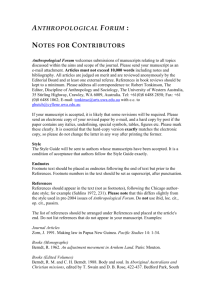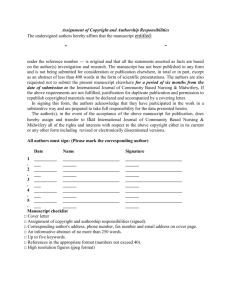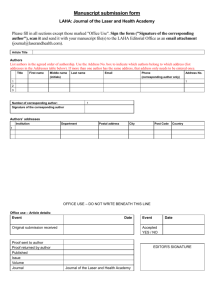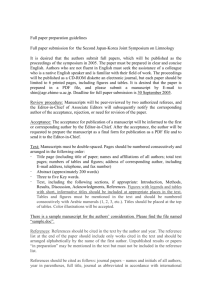GUIDE FOR AUTHORS
advertisement
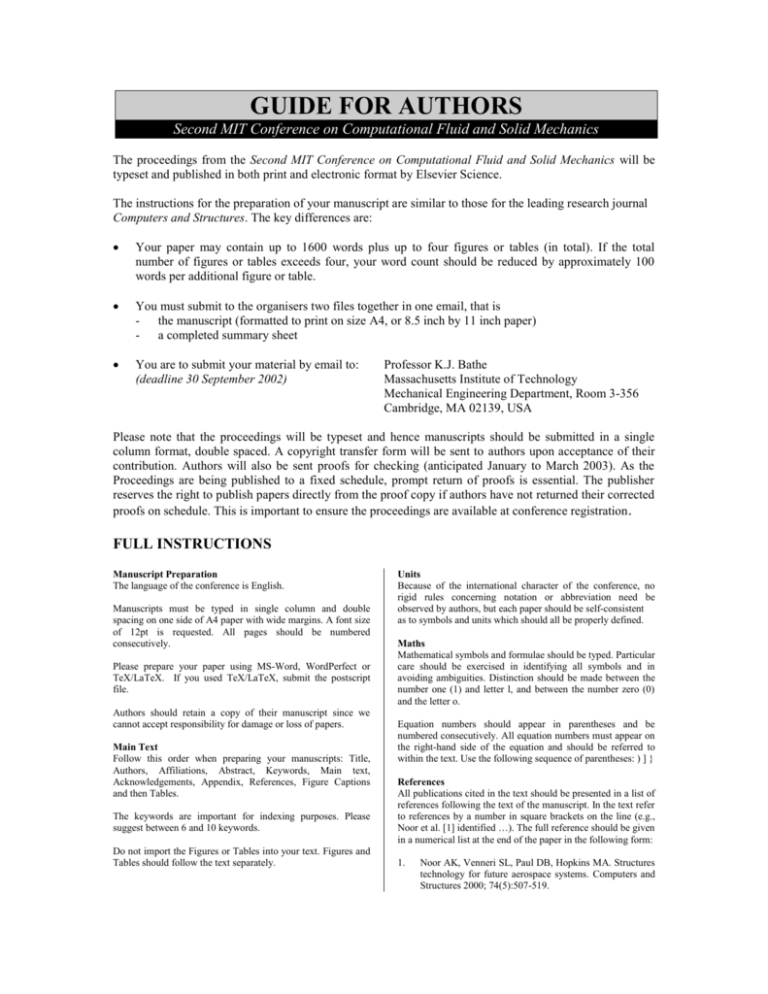
GUIDE FOR AUTHORS Second MIT Conference on Computational Fluid and Solid Mechanics Conference on Computational Fluid and Solid Mechanics The proceedings from the Second MIT Conference on Computational Fluid and Solid Mechanics will be typeset and published in both print and electronic format by Elsevier Science. The instructions for the preparation of your manuscript are similar to those for the leading research journal Computers and Structures. The key differences are: Your paper may contain up to 1600 words plus up to four figures or tables (in total). If the total number of figures or tables exceeds four, your word count should be reduced by approximately 100 words per additional figure or table. You must submit to the organisers two files together in one email, that is - the manuscript (formatted to print on size A4, or 8.5 inch by 11 inch paper) - a completed summary sheet You are to submit your material by email to: (deadline 30 September 2002) Professor K.J. Bathe Massachusetts Institute of Technology Mechanical Engineering Department, Room 3-356 Cambridge, MA 02139, USA Please note that the proceedings will be typeset and hence manuscripts should be submitted in a single column format, double spaced. A copyright transfer form will be sent to authors upon acceptance of their contribution. Authors will also be sent proofs for checking (anticipated January to March 2003). As the Proceedings are being published to a fixed schedule, prompt return of proofs is essential. The publisher reserves the right to publish papers directly from the proof copy if authors have not returned their corrected proofs on schedule. This is important to ensure the proceedings are available at conference registration . FULL INSTRUCTIONS Manuscript Preparation The language of the conference is English. Manuscripts must be typed in single column and double spacing on one side of A4 paper with wide margins. A font size of 12pt is requested. All pages should be numbered consecutively. Please prepare your paper using MS-Word, WordPerfect or TeX/LaTeX. If you used TeX/LaTeX, submit the postscript file. Authors should retain a copy of their manuscript since we cannot accept responsibility for damage or loss of papers. Main Text Follow this order when preparing your manuscripts: Title, Authors, Affiliations, Abstract, Keywords, Main text, Acknowledgements, Appendix, References, Figure Captions and then Tables. The keywords are important for indexing purposes. Please suggest between 6 and 10 keywords. Do not import the Figures or Tables into your text. Figures and Tables should follow the text separately. Units Because of the international character of the conference, no rigid rules concerning notation or abbreviation need be observed by authors, but each paper should be self-consistent as to symbols and units which should all be properly defined. Maths Mathematical symbols and formulae should be typed. Particular care should be exercised in identifying all symbols and in avoiding ambiguities. Distinction should be made between the number one (1) and letter l, and between the number zero (0) and the letter o. Equation numbers should appear in parentheses and be numbered consecutively. All equation numbers must appear on the right-hand side of the equation and should be referred to within the text. Use the following sequence of parentheses: ) ] } References All publications cited in the text should be presented in a list of references following the text of the manuscript. In the text refer to references by a number in square brackets on the line (e.g., Noor et al. [1] identified …). The full reference should be given in a numerical list at the end of the paper in the following form: 1. Noor AK, Venneri SL, Paul DB, Hopkins MA. Structures technology for future aerospace systems. Computers and Structures 2000; 74(5):507-519. 2. 3. Hartmann D, Baitsch M, Weber H. Structural optimization in consideration of stochastic phenomena — a new wave in engineering. In: Bathe KJ, editor. Computational Fluid and Solid Mechanics. Oxford: Elsevier Science, 2001. Haftka RT, Rdal GZ, Kamat MP. Elements of structural optimization. London: Kluwer Academic, 1990. Illustrations All illustrations should be provided in disc graphic format, suitable for direct reproduction (which may include reduction) without retouching. All photographs, charts and diagrams are all to be referred to as "Figure(s)" and should be numbered consecutively in the order to which they are referred. They should accompany the manuscript, and should not be included within the text. (2) Computer-generated figures. EPS is the only format for computer-generated line-art that is acceptable. Do not send file formats such as GIF, BMP, PICT, WPG or DOC and do not send graphic / image files enclosed in MS-Word, WordPerfect, Excel, Powerpoint or any such program. EPS is resolution independent, and gives very good results. Please make sure that all layers / items of the EPS graphic are ‘grouped’ and ‘locked’. Fonts used in EPS graphics should be either embedded or supplied as a separate font map, preferably as an outline font. Please make sure that all unwanted elements have been removed from the graphic. Other formats for computer-generated line-art are not always usable and printouts must be supplied in these cases. We request that you send computer-generated line-art in EPS format. All figures are to have a caption. Line drawings Good quality printouts on white paper produced in black ink are required. To this end, all line drawings are to be submitted as graphics files according to the following section, “Graphics Files”. All lettering, graph lines and points on graphs should be sufficiently large and bold to permit reproduction when the diagram has been reduced to a size suitable for publication in the proceedings. Scans of dye-line prints or photocopies are not suitable for reproduction. Avoid the use of shading on computer-generated illustrations. Photographs Digital photographs are preferred, in highest resolution JPEG format. Scanned photographs may not be suitable for reproduction. Scans of photocopies of photographs are not acceptable. We will assume all colour images are to be printed in black & white unless otherwise instructed (the author will be required to fund the extra printing costs for any colour printing required). However, the publisher will endeavour to reproduce colour images in colour on the CD-ROM version of the proceedings. Tables Tables should be numbered consecutively and given a suitable caption and each table typed on a separate sheet. Footnotes to tables should be typed below the table and should be referred to by superscript lowercase letters. No vertical rules should be used. Tables should not duplicate results presented elsewhere in the manuscript, (e.g., in graphs). Graphic Files (1) Scanned figures. In general the following requirements hold: Line-art should be scanned at between 600 and 1200 dpi, depending on the degree of detail of the illustration, and preferably be saved as TIFF, LZW-compressed; half-tones should be scanned at 300 dpi, preferably saved in JPEG format at the highest quality option. Line/tone combinations should be scanned at a minimum of 500 dpi and saved as either JPEG or TIFF. Submission All authors must submit only the electronic copy of their paper. Always keep a backup copy of the file for reference and safety. It does not really matter which computer or word-processor you use. Any word-processor that runs on a PC or Macintosh is acceptable, but you must submit your paper in DOC (MSWord), WPD (WordPerfect) or PS (Postscript) format. Please ensure that you detail the package used in the Summary Sheet. Kindly note that we intend to edit and to use your file for publishing. We request therefore that you follow these Instructions closely. Proofs Proofs will be sent to the author (first named author if no corresponding author is identified of multi-authored papers) and should be returned within 48 hours of receipt. Corrections should be restricted to typesetting errors; any others may be charged to the author. Any queries should be answered in full. Please note that authors are urged to check their proofs carefully before return, since the inclusion of late corrections cannot be guaranteed. Copyright All authors must sign the "Transfer of Copyright" agreement before the article can be published. This transfer agreement enables Elsevier Science Ltd to protect the copyrighted material for the authors, but does not relinquish the author's proprietary rights. The copyright transfer covers the exclusive rights to reproduce and distribute the article, including reprints, photographic reproductions, microfilm or any other reproductions of similar nature and translations. Includes the right to adapt the article for use in conjunction with computer systems and programs, including reproduction or publication in machine-readable form and incorporation in retrieval systems. Authors are responsible for obtaining from the copyright holder permission to reproduce any figures for which copyright exists.

